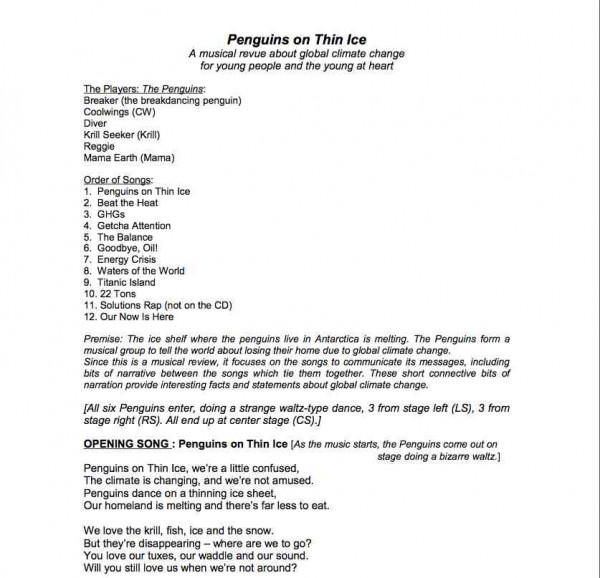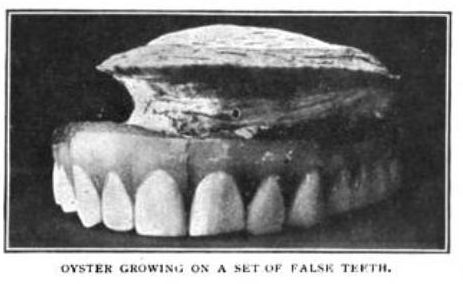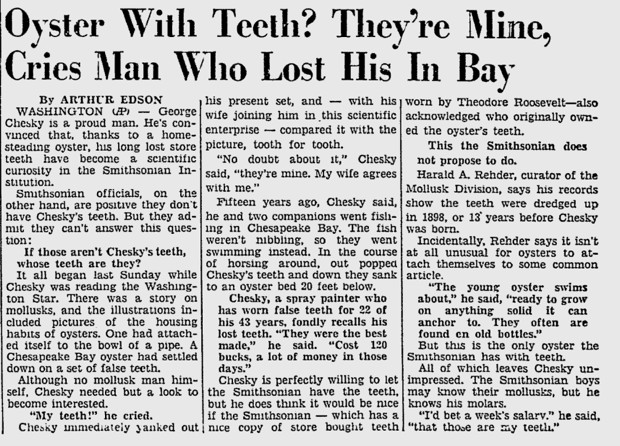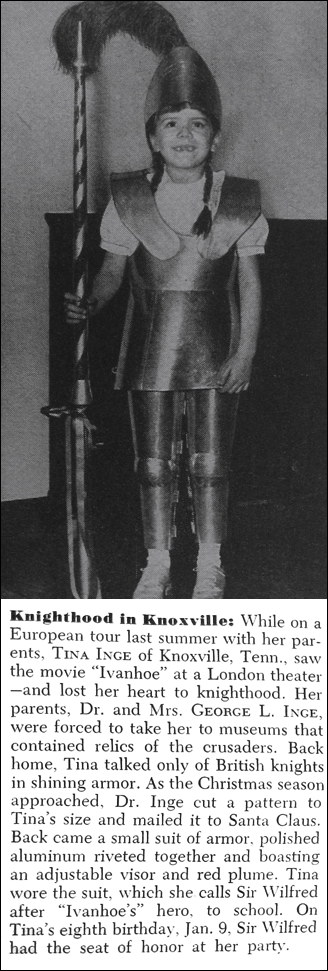November 2012
November 26, 2012
Scarf up some bacon
For only $170, you too can scarf up some this delicious looking bacon!
Click here for the full story!
Posted By: Expat47 - Mon Nov 26, 2012 -
Comments (7)
Category:
Penguins On Thin Ice

In his latest NOTW column, Chuck mentions a "climate change musical" created with government funding.
Here is the home page.
With all the songs as soundfiles you can "enjoy."
You can even download a PDF of the script.

Posted By: Paul - Mon Nov 26, 2012 -
Comments (8)
Category: Ineptness, Crudity, Talentlessness, Kitsch, and Bad Art, Music, Nature
Oyster Growing on a Set of False Teeth

image source: The Strand magazine - 1903
Oysters will grow on almost any surface, including false teeth, if that's what happens to be available. The tooth-growing oyster shown above was found in the Chesapeake Bay in 1898, and sent to the Smithsonian where they were put on display and became quite a popular attraction. But soon a paternity battle erupted around them. The story was told in the Saint Paul Globe (Nov 30, 1902):
And, oddest of all, there is an upper set of false teeth to which an enterprising oyster is firmly attached.
The history of this last oyster is decidedly interesting. About four years ago it was raked out of the waters of Chesapeake bay by a dredging boat, together with the false teeth to which it was firmly fixed, and teeth and oyster were acquired by a hotel keeper at Cowart, Va., whose wife forwarded them to the Smithsonian Institution at Washington. The matter obtaining some advertisement, a man named Webster, residing in Bedford, Iowa, claimed the teeth, saying that he had lost them from a steamer bound for Norfolk.
The Smithsonian officials were undecided at first as to whether they should surrender the teeth or not, the object being so great a curiosity that they were anxious to hold on to it. But not many days later a Philadelphia woman claimed them, asserting that they were hers, and actually a third party, visiting the institution, demanded them, declaring that he recognized them as having been lost by himself.
Probably, from first to last, a good many persons have lost their false teeth overboard in the Chesapeake, the waters of which are liable to be pretty rough at times. Any way, the government scientists did not care to decide the dispute, and concluded to retain the specimen.
Half a century later, in 1954, yet another guy insisted the teeth were his, but in this case the Smithsonian was able to definitively rule out his claim, pointing out that the guy hadn't even been born yet when the teeth were found.
I'm guessing the Smithsonian probably still has this tooth-growing oyster hidden away somewhere in its archives.

Daytona Beach Morning Journal - Jan 28, 1954
Posted By: Alex - Mon Nov 26, 2012 -
Comments (3)
Category: Freaks, Oddities, Quirks of Nature, Museums, Oceans and Maritime Pursuits, Natural Wonders
November 25, 2012
Trotify your Bicyle
Even Gilligan didn't think of this use for a coconut!
Posted By: Alex - Sun Nov 25, 2012 -
Comments (9)
Category: Bicycles and Other Human-powered Vehicles
Oh Christmas Tree

Oh Christmas tree, oh Christmas tree, golden are thy branches! Bet they paid more to Disney in licencing fees than for the gold.
Posted By: Alex - Sun Nov 25, 2012 -
Comments (5)
Category: Holidays
The Klansman

If the poster allures, the full movie follows. Please listen to the theme song, if nothing else.
Posted By: Paul - Sun Nov 25, 2012 -
Comments (7)
Category: Movies, Racism, Stereotypes and Cliches, Stupid Criminals, 1970s
A Knight in her Armor
Came across this in Newsweek, Jan 19, 1953. I bet a lot of WUvies were pretty weird as kids, but how many of us wore suits of armor to school? And this was several decades before the invention of Dungeons & Dragons. I wonder what became of Tina Inge. She's quite likely still out there somewhere, but is she still wearing her armor?
Posted By: Alex - Sun Nov 25, 2012 -
Comments (3)
Category: Children, 1950s
November 24, 2012
Shweeb
Why am I thinking of the opening credits of Futurama?
Posted By: Paul - Sat Nov 24, 2012 -
Comments (4)
Category: Bicycles and Other Human-powered Vehicles, Technology, New Zealand
The EyeSee Mannequin
It's the newest innovation in mannequin technology. It watches customers with the camera installed in its eye, recording details such as age, race, and gender. It also keeps an eye out for shoplifters. Be cool to have one of these as a home security camera. Keep it standing in the window, watching everyone who walks up to the door. [Yahoo! News]
Posted By: Alex - Sat Nov 24, 2012 -
Comments (4)
Category: Inventions, Robots, Technology
November 23, 2012
Edible Deodorant

Eat the candy so you smell sweet, and its even sugar free!
Posted By: Alex - Fri Nov 23, 2012 -
Comments (7)
Category: Perfume and Cologne and Other Scents
| Get WU Posts by Email | |
|---|---|

| Who We Are |
|---|
| Alex Boese Alex is the creator and curator of the Museum of Hoaxes. He's also the author of various weird, non-fiction books such as Elephants on Acid. Paul Di Filippo Paul has been paid to put weird ideas into fictional form for over thirty years, in his career as a noted science fiction writer. He has recently begun blogging on many curious topics with three fellow writers at The Inferior 4+1. Chuck Shepherd Chuck is the purveyor of News of the Weird, the syndicated column which for decades has set the gold-standard for reporting on oddities and the bizarre. Our banner was drawn by the legendary underground cartoonist Rick Altergott. Contact Us |

